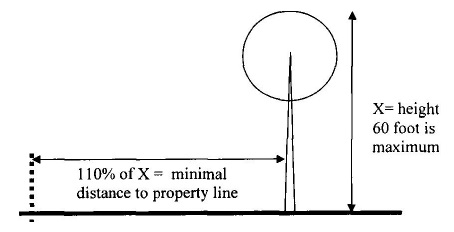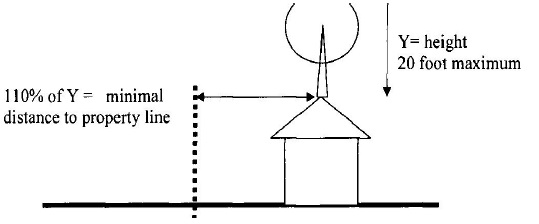All on-site wind energy conversion systems and supporting anemometer towers, if under 60 feet in height, shall conform to the following standard.
(A) Purpose. Designed to primarily serve the needs of a home, farm or small business.
(B) Height. Shall have a height of 60 feet or less. Applicants may request special use approval from the Planning Commission to waive height restrictions for towers located at school, institutional or governmental properties.
(C) Property setback.
(1) The distance between an on-site use wind energy system and the owner’s property lines shall be equal to 110% of the height of the wind energy system including the top of the blade in its vertical position.
(2) If a system is installed on a roof, the setback shall be calculated based on the total system height above the roof, not including the structure below the point it is mounted on the roof.
(3) The distance between an anemometer tower and the owner’s property lines shall be equal to the height of the tower. No part of the wind energy system structure, including guy wire anchors, may extend closer than ten feet to the owner’s property lines, or the distance of the required setback in the respective zoning district, whichever results in the greater setback. Wind energy conversion systems shall not be located between the front lot line and the front wall of a dwelling.
Graphic 1 Ground systems

Graphic 1 B Roof Mounted

(D) Sound pressure level. On-site use wind energy systems shall not exceed 55 dB(A) at the property line closest to the wind energy system. This sound pressure level may be exceeded during short-term events such as utility outages and/or severe wind storms. If the ambient sound pressure level exceeds 55 dB(A), the standard shall be ambient dB(A) plus 5 dB(A).
(E) Construction codes and towers. On-Site Use wind energy systems including towers shall comply with all applicable state construction and electrical codes and local building permit requirements. On-site use wind energy systems including towers shall comply with Federal Aviation Administration (FAA) requirements, the Michigan Airport Zoning Act (Public Act 23 of 1950, M.C.L.A. §§ 259.431 et seq.), the Michigan Tall Structures Act (Public Act 259 of 1959, M.C.L.A. §§ 259.481 et seq.), and local jurisdiction airport overlay zone regulations.
(F) Interconnection standards. An interconnected on-site use wind energy system shall comply with the State Public Service Commission and Federal Energy Regulatory Commission standards. Off-grid systems are exempt from this requirement.
(G) Braking. An on-site use wind energy system shall have automatic braking, governing or a feathering system to prevent uncontrolled rotation or over speeding.
(H) Lightning protection. All wind towers shall have lightning protection.
(I) Guy wires. If a tower is supported by guy wires, the wires shall be clearly visible to a height of at least six feet above the guy wire anchors.
(J) Blade to ground clearance. The minimum vertical blade tip clearance from grade shall be 20 feet for a wind energy system employing a horizontal axis rotor.
(K) Engineering approval. Engineering considerations in this subchapter shall involve the approval of a certified engineer. That shall include, but not be limited to: FAA compliance; airport zoning; tall structures; public service commission; federal energy regulations; braking; and lightning protection. The structural integrity shall conform to the design standards of the International Electrical Commission, specifically:
(1) IEC 61400- 1 Wind Turbine Safety and Design; and/or
(2) IEC 61400- 2 Small Wind Turbine Safety;
(3) IEC 61400-22 Wind Turbine Certification; and
(4) IEC 61400-23 Blade Structure Testing or any similar successor standards.
(L) Illumination. Wind energy conversion systems may not be artificially lighted unless otherwise required by the FAA or approved authority or authorized by the Planning Commission.
(M) Access.
(1) Ground access. Towers that are not roof-mounted shall be enclosed with a six-foot tall fence or the base of the tower or pedestal shall not be climbable for a distance of 12 feet.
(2) Roof access. When roof mounted wind energy conversion systems are meant to be accessed by the public, the Planning Commission or City Manager may require additional guards or warnings to ensure safety.
(N) Unsafe or inoperative systems.
(1) Any wind energy conversion systems found to be unsafe by a City Building Official shall be repaired by the system owner to meet all code requirements or be removed as directed by the city.
(2) If any wind energy conversion systems are not used for a period of 12 months, the system owner will be notified by certified mail to set forth reasons for the operational difficulty and provide a reasonable timetable for corrective action. If one is not provided to the satisfaction of the city, the landowner shall remove the wind energy conversion system(s) with 60 days of receipt of a certified mail notice to remove.
(O) Signal interference. wind energy conversion systems shall not interfere with communication systems such as, but not limited to, radio, telephone, television, satellite or emergency communication.
(P) Number. Wind energy conversion systems in residential areas may consist of one to five wind turbines, tower or pedestals and their associated control or conversion electronics.
(Ord. 190, passed 6-7-2010)